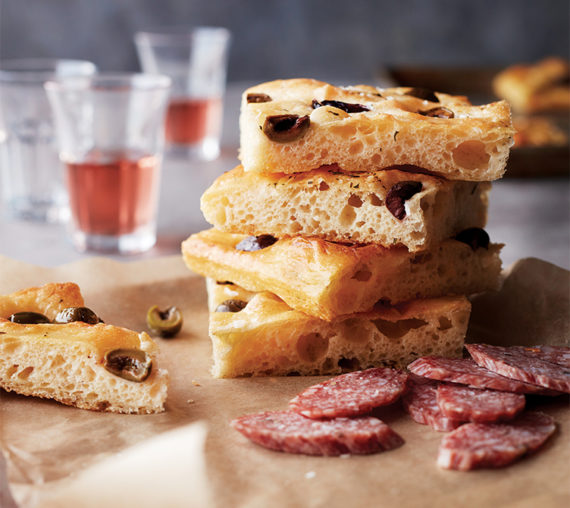Potato Focaccia with Olives and Rosemary
Welcome guests to your home for dinner with a glass of California rosé and a slice of warm olive focaccia. If you’ve baked the focaccia hours before, you can reheat it quickly in a hot oven, although it’s plenty tasty at room temperature, too. Pack it on a picnic or a hike with your favorite salumi and cheeses. Or adapt the topping to showcase a seasonal fresh vegetable like halved cherry tomatoes or strips of roasted sweet pepper. Adding cooked potato to the dough produces an especially moist and tasty result.
Pairs With


Ingredients
- 1⁄2 pound (250 g) Yukon Gold potatoes, unpeeled
- 1 1⁄2 teaspoons active dry yeast
- 3 3⁄4 cups (465 g) unbleached all-purpose flour, plus more for kneading
- 2 1⁄2 teaspoons (8 g) kosher or sea salt, plus more for sprinkling
- 1⁄4 cup (60 ml) extra virgin olive oil, plus more for coating and brushing
- 24 California olives, pitted and halved
- 1 1⁄2 teaspoons finely minced fresh rosemary or dried oregano, finely crumbled
Makes one 11-by-17-inch (28 by-43 cm) focaccia
Instructions
Put the potatoes in a small saucepan and add water to cover by 1 inch (2.5 cm). Do not add salt. Bring to a simmer over high heat, adjust the heat to maintain a gentle simmer, and cook until the potatoes are tender when pierced, 15 minutes or more, depending on size.
Remove from the heat, set aside 1 1∕3 cups (330 ml) of the potato water, and then drain the potatoes. When cool enough to handle, peel the potatoes and pass them through a ricer or food mill fitted with a fine disk into a bowl. If you don’t have a ricer or food mill, mash the potatoes well with a potato masher.
Refrigerate the potato water until it cools to 105° to 115°F (40° to 46°C). Put 1∕3 cup (80 ml) of the cooled potato water in a large bowl and sprinkle the yeast over it. Let soften for about 3 minutes, then whisk with a fork to dissolve and let stand until bubbly, about 10 minutes.
Meanwhile, in a bowl, combine the flour and salt and whisk to blend.
Add the olive oil, riced potato, and the remaining 1 cup (250 ml) potato water to the proofed yeast. Stir to combine, then add the flour gradually, stirring with a wooden spoon until the dough clears the sides of the bowl. Keeping the dough in the bowl, knead it gently by hand until smooth, adding just enough additional flour to keep it from sticking to your hand. You should not need more than 1 to 2 tablespoons. Shape the dough into a ball and coat lightly with olive oil. Cover the bowl tightly with plastic wrap and let the dough rise until doubled, 1 1∕2 to 2 hours.
Punch the dough down. Using 1 tablespoon olive oil, grease the bottom and sides of an 11-by-17-inch (28-by-43 cm) rimmed baking sheet. Transfer the dough to the baking sheet. With well-oiled fingers, poke and prod the dough into a rectangle that fits the pan. The dough is elastic and will want to spring back. If it resists your attempts to flatten it enough to cover the pan, let it rest for 5 minutes and try again. If it still springs back from the edges, let it rest for 5 minutes longer and try once more. You should be able to flatten it sufficiently after a couple of rests, but don’t worry if the dough doesn’t completely fill the pan. Let rise, uncovered, until puffy, about 1 1∕2 hours.
While the dough rises, preheat the oven to 400°F (200°C). If you have a pizza stone (or baking tiles), put it in the oven on the middle rack to preheat—ideally for at least 30 minutes before baking.
Arrange the olives, evenly spaced, on the surface of the focaccia, then gently press them into place. Brush the surface of the dough with 1 tablespoon olive oil, then scatter the rosemary and a little salt on top. Place the pan on the baking stone, if using, and bake until the focaccia is golden brown, 20 to 25 minutes, rotating the baking sheet back to front halfway through.
Immediately slide a long metal offset spatula under the focaccia to make sure it is not sticking to the baking sheet, then slide the focaccia onto a rack to cool. Slice into desired portions with a bread knife and serve warm or at room temperature.

Pairs With






